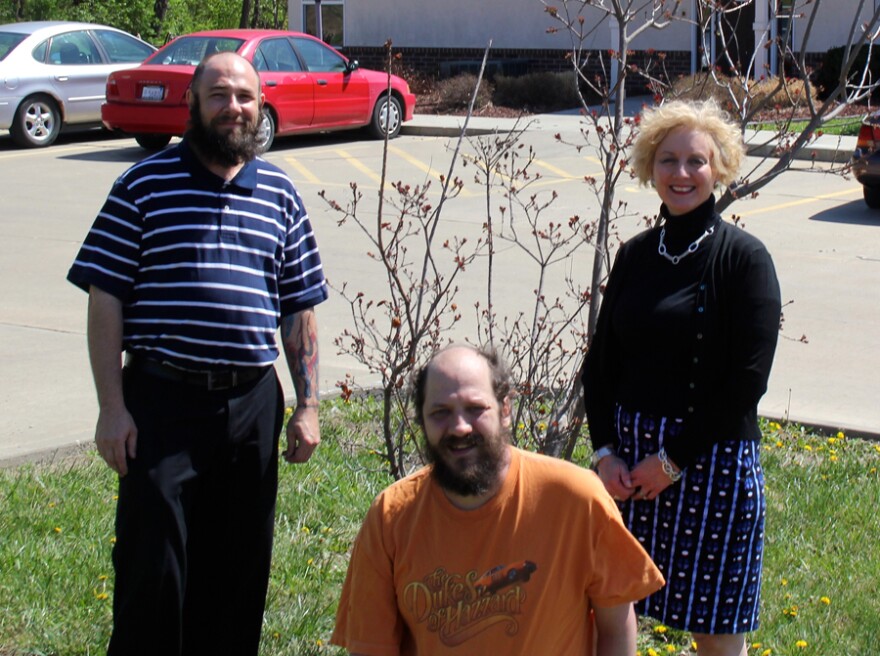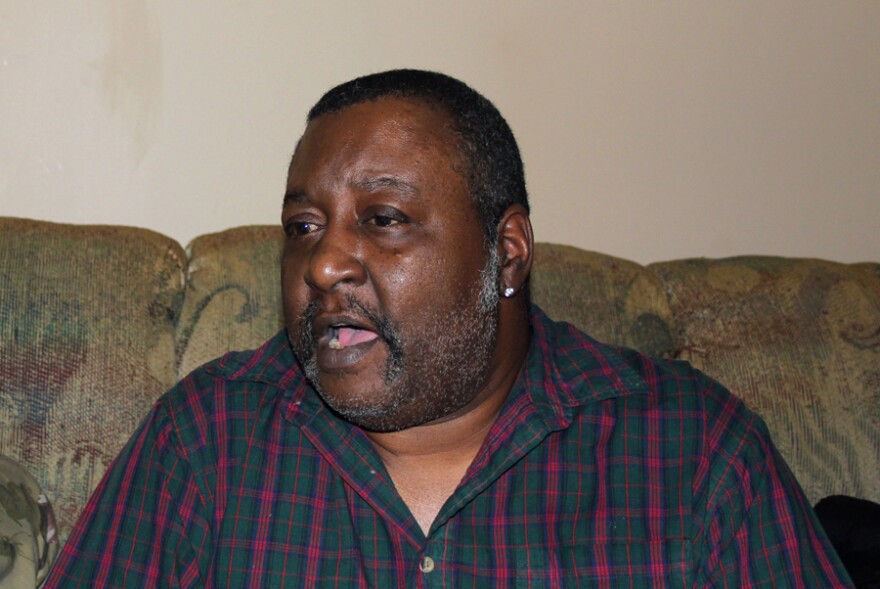A group of men in the vanguard of a new model of housing for chronically homeless people with mental illnesses sat around a small conference table eating pizza recently in Leavenworth.
It was the monthly social gathering for residents of the Marion Apartments, a single-story, 10-unit complex just off Main Street.
The building is unremarkable, like many other apartment complexes. That’s by design, according to Susan Crain Lewis, president and CEO of Mental Health America of the Heartland, a nonprofit that supports people with mental health problems in Kansas and Missouri.
What makes Marion Apartments remarkable is that residents can stay there as long as they want.
It’s a model called permanent supportive housing that flips the more traditional forms of housing assistance in the mental health realm by assuming that successful treatment follows housing stability, not the other way around.
In the post-institutionalization era of mental health treatment in America, the usual model of support for people with mental illness is temporary hospitalization and treatment following a psychotic episode, then a temporary stay in “transitional housing” before patients are expected to obtain and secure housing on their own in the private market.
But Lewis and others think that creates dangerous instability for some people with severe and persistent mental illness. That instability, they say, creates a cycle of lapses in treatment, more psychotic episodes, more homelessness and more trips to county jails and state hospitals that start the process all over again.
The antidote, they say, is an open-ended place to stay that allows people with a mental illness to get comfortable with their surroundings and fall into a routine that makes them better able to manage their conditions.
That “Housing First” model is gaining favor with the federal government. Los Angeles County made national news last year when it opened a $40 million, 102-unit complex to provide permanent supportive housing to the city’s Skid Row residents.
Initial research suggests there’s merit to the movement, and Lewis and her colleagues say they’ve seen the results firsthand.
Before coming to Marion, the men around the table were sleeping under bridges or on friends’ couches or squatting in doorways, in and out of mental hospitals or jail cells. Now they feel at home. Several of the 10 residents — nine men and one woman — have been at Marion since it opened in 2005. Hospitalizations are exceedingly rare, in part because of the on-site therapy they receive from peer support counselors, but also because of the support they give each other.
Some are working now, and last year all of the residents either maintained or increased their income level. Lewis’ organization is allowed to charge rent of up to 30 percent of a resident’s income, but those who can’t pay don’t have to.
Marion Apartments, and two other permanent supportive housing complexes the organization operates on both sides of the state line in Kansas City, are funded through a mix of federal grants and donations from local individuals, corporations and charitable groups.
Lewis believes strongly in permanent supportive housing. With Kansas in particular facing a reduction in beds for acute care of people with mental illness, her organization would like to help break the cycle of hospitalization.
But Lewis said her permanent supportive housing units are “pretty much always full.”
“If money were no object, we would build more,” she said. “At this point, our organization is not in a position to take on any more.”
Cost-effective
Lewis said her organization has not received any increase in funds from the U.S. Department of Housing and Urban Development in years.
The state government, more focused on short-term budget fixes now than long-term investments, is unlikely to contribute.
Kansas also is in the midst of a conservative revolution that has the Legislature frequently discussing the proper role of government.
Lewis bristles when asked if it’s the government’s role to provide people with mental illness with an apartment for the rest of their lives.
“Is it the government’s role to provide them with a jail cell off and on for the rest of their life instead?” she asks.
Ray Roberts, secretary of the Kansas Department of Corrections, has repeatedly told legislators that people with mental illnesses, substance abuse addiction or a combination of the two make up a large share of the state’s prison population.
In 2013, he said 38 percent of adults incarcerated in the state had a mental illness and the prison system’s mental health beds are “always full.”
Statistics on people with mental illness being held in county jails are harder to pin down, but Lewis said it’s common, especially among the chronically homeless.
Local law enforcement officers pick them up for infractions like public urination, she said, because they don’t have their own bathrooms and they’ve been shut out of public restrooms because of how they look or smell.
“I’m a taxpaying citizen,” Lewis said. “I would really prefer law enforcement officers are chasing bad guys around.”
She said police officers she’s talked with have said they’d also rather focus on violent crime.
Those police calls related to mental health issues cost taxpayer money, as does locking up people with mental health problems. Lewis said it costs about $43.50 per day to house someone at a facility like the Marion Apartments, while a day in a county jail or state prison costs almost $70.
“What could the state of Kansas do with an additional $26 per person, per day?” she said. “And let’s not even talk about what the state psychiatric facilities cost.”
A day in a state hospital for people with mental illness can cost about $500.
Those days come far too frequently in Kansas, Lewis said. She pointed to a data analysis that showed the 30-day and 180-day readmission rates for adults in Kansas state hospitals in 2013 were among the highest in the nation.
Christopher Leach, the residential manager at Marion, said that when people leave the hospital and head to transitional housing, they have the uncertainty of a move-out date “looming over them.” Being at Marion, he said, removes that uncertainty so “they can really start focusing on recovery.”
That leads to better treatment compliance, fewer hospitalizations and ultimately cost savings.
“When people come into permanent supportive housing, there is a lot less need for hospitalization and acute care,” Leach said. “That’s expensive stuff.”
More humane
Leach, who also is one of the peer support counselors at Marion, dished out slices of pizza from cardboard boxes in the kitchen of the room where the residents had their social gathering.
With spring in the air, he asked them what they wanted to plant in their communal garden this year.
“Get some of them big beefsteak tomatoes,” one resident said. “I really like those.”
“Last year the okra turned out really well,” another said.
In some ways Marion is much like any other housing complex.
Residents come and go as they please. Some have cars. They are allowed to have visitors. They can choose to smoke or drink in their room if they want. Two residents fell in love and got married a few years ago, Lewis said.
But it is clearly a more tight-knit group than average apartment-dwellers.
In addition to the monthly social events, they meet for group therapy sessions, make crafts and have show-and-tell sessions where they display their movie collections or models.
Leach said the residents “really consider it a family.”
“That adds stability where some folks haven’t had stability for a long time,” he said of the complex.
Leach, who sports an unusual combination of buttoned polo shirt and dark slacks with tattoos and a bushy beard, knows from experience. He’s in recovery himself, he said, after spending most of seven years drifting from place to place, losing count of how many spots he’d slept in.
“Until I had stable housing, I was never able to get a grip on what recovery was all about and get anywhere in life,” Leach said.
William Scaife, 58, is one of the residents who has been at Marion since 2005.
He said before that he had been homeless “off and on” since he left the U.S. Marine Corps in 1982.
“There’s two of us here, ex-Marines, jarheads,” Scaife said.
Including all branches, six military veterans currently occupy Marion’s 10 units.
Scaife said he joined the Marines after a difficult childhood in “the projects.” His father left the home when he was 5 years old and he was abused by a babysitter and bullied at school until he became involved with sports in high school.
He watched his father sell pot and, not wanting to end up like him, turned to the military as a way out, enlisting in 1979.
That’s where signs of mental illness first started to crop up, he said, and the drinking he did on the base only made them worse.
“That’s when I realized I can’t handle alcohol,” Scaife said.
Scaife served for three years in a radio operator group and the infantry, including tours in Okinawa and the Philippines.
When he got out, he started hearing voices in his head and spent time at Osawatomie State Hospital in 1983 and 1984. That was the beginning of a long stretch of eking out survival despite homelessness and low-wage jobs that did not end until he came to Marion in 2005.
Scaife’s apartment is small, but it includes a stationary bike and a heavy barbell that he says he still uses on good days, when his back problems, acid reflux and diabetes aren’t bothering him.
Having his own permanent space is good, but he says sharing it with others in the complex is a major part of what has made Marion a good fit for him.
“It gives you a kind of freedom to have your own leisure time, where you can absorb the energy around you,” Scaife said.
Success stories

Lewis hugs Scaife before leaving his room and telling him how proud she is of him.
His is only one of many success stories, she said upon her return to the community kitchen where James Reed, another 10-year Marion resident, has fixed her a pot of coffee.
One of Marion’s former female residents, Lewis said, came to the complex after living under a bridge.
After getting settled, the woman went back to school and earned a bachelor’s degree. She now works full-time in children’s services, Lewis said.
“She helps kids and she pays taxes,” Lewis said. “(She) has a nice house.”
Another female resident was diagnosed with terminal cancer after moving into the Marion Apartments.
Her doctors asked if she wanted to go into hospice care, but Lewis said the woman told them no, she wanted to go “home” — to Marion.
When she returned she told the other residents that in lieu of a memorial service after her death, she wanted to have a party before she died. So everyone gathered for a celebration catered by her favorite restaurant. Then they planted a tree in front of the apartment complex in her honor.
“That was a life party — that’s what we called it,” Reed said as he examined the tree.
The woman also told her fellow residents that one of her last wishes was to see the ocean before she died. A resident who owned a car drove her to Texas, where she captured some seawater in a plastic bottle and gave it to Lewis as a thank-you gift.
Years later, Lewis still gets emotional when she sees the bottle.
“This place chokes me up,” she said.
Andy Marso is a reporter for KHI News Service in Topeka, a partner in the Heartland Health Monitor team.




